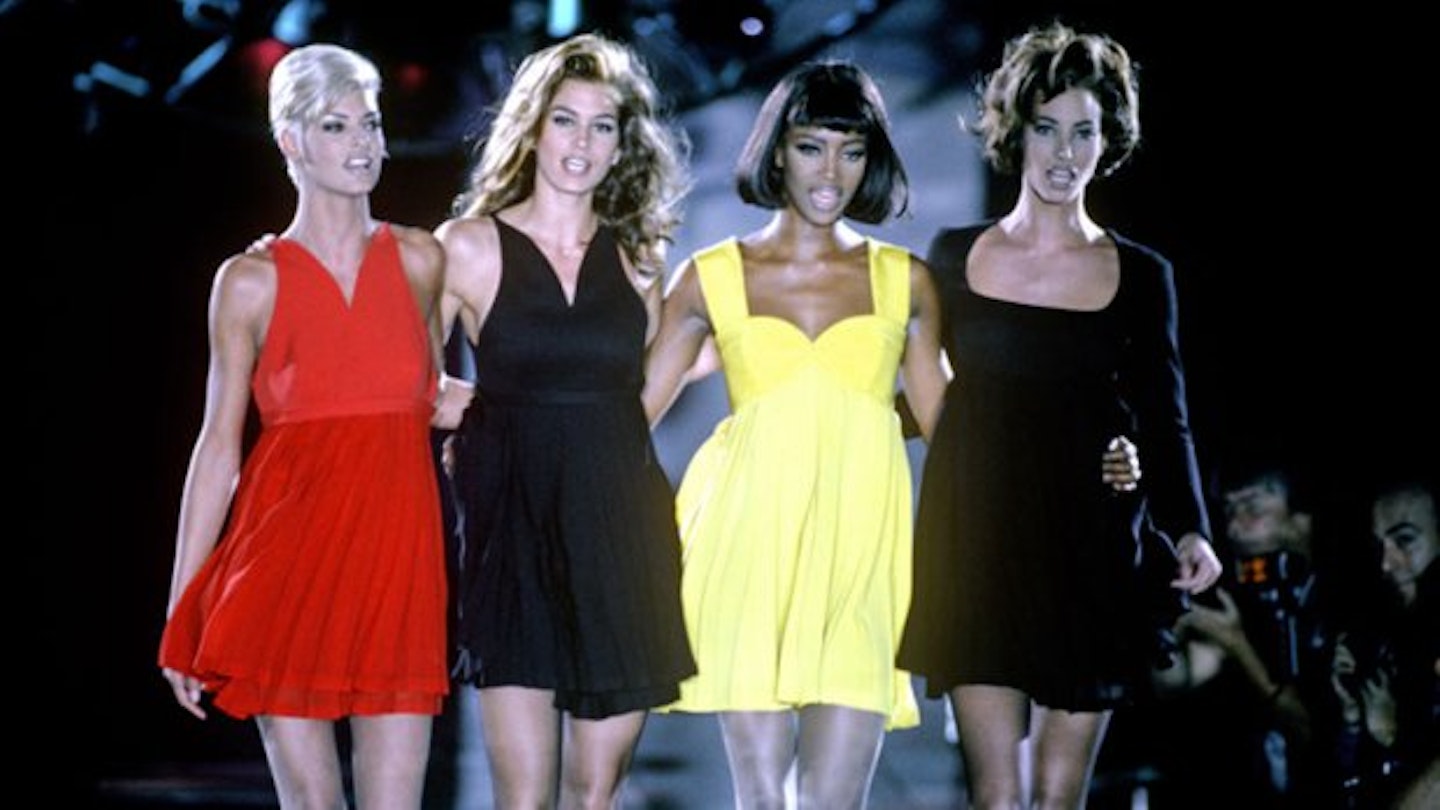Before the internet was even around to be broken, Gianni Versace stopped the world in its tracks. The year was 1991, and Italian labels were on the top of their game with up-and-coming names like Dolce & Gabbana, Armani and Valentino dominating the style press’ headlines. But, it was Versace that created a seminal, era-defining moment.
Moving away from the classic formula of a single model sauntering towards the waiting, hungry pit of photographers and then back, Versace sent out his models in packs during his autumn winter '91 show. Like an army's battalion, long-legged women with bouncy blow drys sauntered down the catwalk in twos, threes and in the final twist a group of four arm-in-arm. To the uplifting beat of George Michael’s Freedom Linda Evangelista, Cindy Crawford, Naomi Campbell, and Christy Turlington with linked elbows twirled down the catwalk smiling, laughing and pouting. Gianni’s clever twist on the fashion show format was actually a reprise of Michael’s video which the four women starred in. From that day forth Versace was crystallised in the collective style psyche long before Instagram existed to document the moment.
‘That Versace show when me, Linda, Christy, and Naomi all came out together’, Cindy Crawford said in an interview with V Magazine, ‘We had just done the George Michael video, Freedom, and it was playing at the show...George Michael was in the front row, and we came out skipping and holding hands. It felt like all the stars had aligned.’
Gianni can be credited with producing one of the first modern runway shows. He thrust the phenomenon into the public eye, taking it from a small, cliquey press and buyers event into a front page-worthy spectacle. He created a space where musicians, movie stars and models mingled.
Models as celebrities wasn’t a new concept – Twiggy and Jean Shrimpton catapulted the industry into mainstream consciousness some 20 years earlier – but it was Gianni who created the ‘supermodel’ phenomenon. Before the waif, heroin-chic look of the mid-'90s took hold, the ‘supers’ with their Amazonia height, athletic curves and classical good looks were the look of the time. At the peak of their fame, in 1990, Linda Evangelista spelt out to Vogue the price of their demand, saying, ‘We don’t wake up for less than $10,000 a day’.
‘That was a fun time to be a model.’ Cindy also told V, ‘It was a lot of focus on fashion and how all those worlds were colliding. MTV was bringing music and fashion and television together. It just felt really fun, and we were all really busy and really making money.’
At first, the concept of being a supermodel seemed ludicrous to her, ‘I found [that term] silly. What, do we change into capes and tights in phone booths? But with anything, the more you hear it, the more it seeps into your language. What it means to me is that before us models were more two-dimensional—mostly nameless faces on magazine covers.
‘We were the tipping point. Some girls before us, like Twiggy and Lauren Hutton, were making the shift. But what was unique about our group was that there were five of us and we were all very different but looked good together.’
Notably, this all changed when the stock market crashed months later, and the economy waned. When the times got tough this high glam fabulosity no longer sat right. As the music gained momentum, hip hop and grunge trickled onto the catwalks. Out went the healthy-looking curves of the supers and in strutted the svelte, elfin looks of Kate Moss. The irony that Gianni was the bridge between the music and modelling world was lost on no one. But, he too went on to change the type of women he cast and designed for.
Now, over 15 years later, Instagram and Tumblr are littered with runway pictures from this seminal show. If pictures speak 1000 words, then consider us (pleasingly) deafened by this fashion moment.
Like this? Then you might also be interested in:
Ashish’s Anti-Trump Sequins Made LFW Collectively Pause For Thought
Follow Lucy on Instagram @lucyalicemorris
This article originally appeared on The Debrief.
